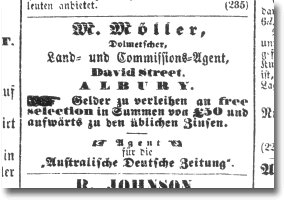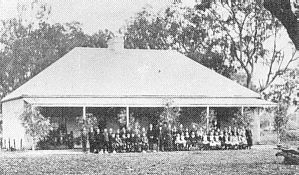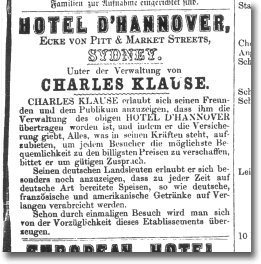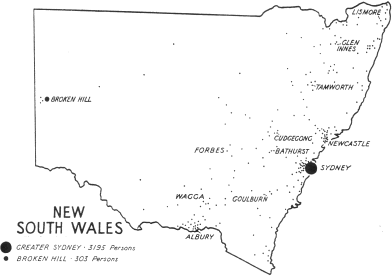![]()
German Settlement in New South Wales in the 19th Century
Up until Victoria's separation (1851) and Queensland's separation (1859), the whole eastern side of the Australian mainland was the colony of New South Wales. As the oldest white-settled part of Australia, the area of the present-day state of NSW had a high proportion of British settlers before any groups of German-speaking immigrants arrived, and it was difficult for non-British immigrants to establish their own settlements, especially as large areas of land were under the control of large sheep farmers (squatters).
However, the squatters needed labourers, shepherds etc for their large properties. Since convict transportation to NSW had been abolished in 1841, landowners found it hard to keep workers, who were always moving on and looking for higher pay, as there was a shortage of workers in the colony. This worker dissatisfaction was especially common among English immigrants. During his early travels in the settled areas of the colony the explorer Ludwig Leichhardt noticed this, and thought that if German immigrants were brought in they would be more likely to settle down and work for a better life than they could have had in Germany. Leichhardt saw many fertile properties lying unproductive because the owner could not pay the wages demanded.
Many landowners were also experimenting with wine-production, and the specialised skills in wine-making (e.g. vine-dressers, barrel-makers etc.) were not available from Britain. The Macarthur brothers asked for special permission to bring in immigrants from the European continent. In 1838 William Macarthur brought six wine-growers and their families from the Hattenheim area in the Duchy of Nassau to improve his vineyards. He won awards in London in 1841 for the wines and brandy that he exhibited.
Landowners still needed cheap, reliable labour, and the NSW Government contracted Wilhelm Kirchner, the Hamburg Consul in Sydney, to go to Germany and recruit immigrants. He succeeded, and in 1849 600 Germans arrived in Sydney (about 104 families) from Silesia in south-eastern Germany and from south-west Germany, where economic circumstances were making life very difficult. In order to promote NSW more widely in Europe, Kirchner published a book in Germany in 1848 entitled Australien und seine Vortheile für Auswanderer (Australia and its Advantages for Emigrants). Of course Kirchner's book was full of praise for life Down Under. The 1850 edition included letters written by German settlers in various parts of NSW who had arrived as a result of his work in Germany. As a result of Kirchner's efforts, another wave of German immigrants arrived in the 1860s, settling in the Illawarra district and around Albury on the Murray River.
|
(Notice appeared in: Cloos, Patricia & Jürgen Tampke (editors). 1993. 'Greetings from the Land where Milk and Honey flows' - the German Emigration to NSW 1838-1858. Southern Highlands Publishers, Canberra. Translation: "Johann Peter Frauenfelder from Hanstadt intends to emigrate to Australia with his family. Anyone claiming there are still financial obligations to be met by the intending emigrant should attend the debt liquidation meeting to be held at this chamber".) |
The Albury Border Post reported on 10th October 1857:
Local Intelligence ... Preaching in German: on Sunday last the German population of Albury were greatly surprised and much delighted in hearing for the first time the Reverend C. Twomey, Roman Catholic clergyman, preaching a sermon in the German language. The Reverend gentleman being newly appointed Parish Priest of this district and finding that a great proportion of the German community did not understand English, thought it necessary to study the German language. Last Sunday's sermon was the fruit of about four months study and perseverance. The German portion of his flock will long remember the impression made on their minds by their new pastor, this being the first time many of them had the pleasure of hearing a sermon preached in their native tongue.
 (Ad
in Australian newspaper "Australische Deutsche Zeitung", 4/11/1870)
(Ad
in Australian newspaper "Australische Deutsche Zeitung", 4/11/1870)
The first homogenous German settlements in NSW were established when in the
late 1860s Germans from places in South Australia such as Mt Gambier, Lights
Pass and Ebenezer moved across to the Albury area. In South Australia the land
in some districts was no longer suitable for farming - artificial fertilizers
were not yet invented. Many farm holdings were too small for Australian conditions.
However, in the area around Albury new land became available. The journeys of
these South Australian Germans took the form of treks, with large numbers of
families, in search of more and better land, followed each other in loaded wagons.
A good description of one such trek in 1868 is recorded, of 56 people travelling
in 14 waggons and two spring carts, with some farm animals. This group of migrants
from South Australia were mainly of Wendish background.
They mainly followed the Murray River to Albury, and had made arrangements in
advance for a Murray paddle steamer to drop food along the way for their animals,
and to take some farm machinery for them. Along the way they met small groups
of Aborigines, and stopped every Sunday to hold church services, and after five-and-a-half
weeks of travelling they rolled into Albury on the 19th November, to an excited
welcome from the people of the town. They moved on, and when they had found
suitable land they named the new settlement Ebenezer (in memory of the place
they'd left in SA), but later it was changed to the present name of Walla Walla,
as an Ebenezer already existed in NSW.
Other German South Australians arrived after similar treks and by 1872 there were four German settlements in the region: Jindera, Bethel, Ebenezer (Walla Walla) and Gerogery. Further north more Germans established settlements in the 1880s at Wallendool (Alma Park), Dudal-Cooma (Pleasant Hills), Munyabla, Mangoplah and Edgehill. In the 1890s smaller settlements with Germans developed at Milbrulong, Henty, Uranquurty, and in the first few years of the 1900s at Temora, Bulgandra, Ungarie and Gilgandra. Settlement occurred on the southern side of the Murray at Middle Creek (Barandudah) and Yackandandah. English farmers were often living alongside the Germans in some of these places.

The first Lutheran school at Jindera, established 1868.
 (Ad
from Australian newspaper: "Germania, Allgemeine deutsche Zeitung für Australien"
24/3/1864)
(Ad
from Australian newspaper: "Germania, Allgemeine deutsche Zeitung für Australien"
24/3/1864)
German tradespeople and professionals did arrive in Sydney and stay put, however
their numbers were small compared to the overall population of the city, and
they therefore never had the strong profile in the city which Germans had in
Adelaide, for example (where in 1900 it was possible to do all your shopping
in the German language). The number of Lutherans in Sydney meant that it wasn't
until 1882 that a Lutheran church was built there, whereas Melbourne's Dreifaltigkeits-Kirche
(Trinity Church) at Eastern Hill was in use in 1855. Adelaide, Melbourne and
Brisbane each had one or more Lutheran congregations almost from the beginning
of German immigration in those colonies.
In other Australian colonies the land was still being opened up when German immigrants arrived on the scene and they were the first white settlers in several areas, but in NSW the good land was largely already taken, and German group settlements could only be established at places far from Sydney like the Riverina, by Germans coming from SA. Therefore, although very many Germans settled in NSW, they were dispersed around the colony in contrast to the Germans in South Australia and Queensland. German Catholics and Lutherans also intermarried to a greater extent in NSW, meaning that generally no closed Lutheran settlements such as in SA were established.

Map: Distribution of the Germans in NSW around 1900 (from: Borrie,
Wilfried. 1954. Italians and Germans in Australia / A Study
of Assimiliation. F.W. Cheshire, Melbourne).
References:
Hebart, Theodor. 1938. The United Evangelical
Lutheran Church in Australia (U.E.L.C.A.): its history, activities and characteristics,
1838-1938. (English version of German original, edited by Johannes J. Stolz).
Lutheran Book Depot, North Adelaide. (facsimile edition - Lutheran Publishing
House, 1985)
Lodewyckx, A. 1932. Die Deutschen
in Australien. Ausland und Heimat Verlagsaktiengesellschaft, Stuttgart.
Meyer, Charles. 1990. A History of Germans in
Australia 1839-1945. Monash University, Clayton (Victoria).
Roderick, Colin. 1988. Leichhardt, the dauntless
explorer. Angus & Robertson, North Ryde NSW. (pp180, 196)
| Top | Back
| Chronology | Issues
| Students | Site Map |
auf Deutsch |
| Primary Sources (in German) | Bibliography
| Search |
German Australia © D. Nutting 2001